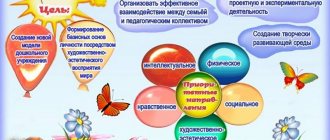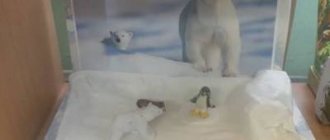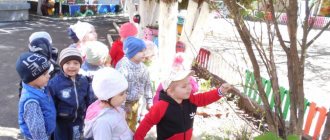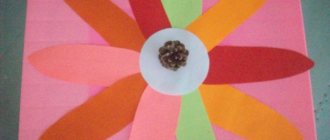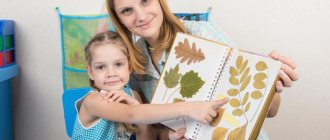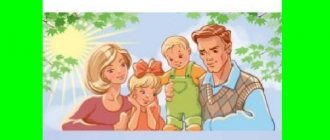Consultations for educators and parents on environmental education
Consultation for educators on the topic:
“Characteristics of the main methods, techniques and means for the formation of environmental education in children of senior preschool age”
Prepared by the teacher
Salatskaya T.G.
In the formation of the ecological culture of a preschool child, an important role is played by the local history approach, which involves a comprehensive study of the nature of the native land and promotes a deeper understanding of the relationships within it, as well as between nature and society.
A comprehensive study of the nature of the native land consists of excursions, targeted walks and routes into nature, visits to the local history museum, as well as work in the local history corner, which is located in the playroom.
During excursions and walks, preschoolers collect certain material that allows them to better study their locality, their region, their region. This material, as well as information about the history, nature of the native land, minerals, water resources, flora and natural world, is contained in the local history corner. The practical activities of children, as one of the conditions for the formation of an ecological culture, are successfully carried out in environmental work, as well as in the vegetable garden and flower beds.
The next condition for the formation of the ecological culture of preschoolers is the personality of the teacher, the characteristics of which are made up of the generalized requirements imposed by the modern level of the educational system. The identification of a creative dominant in professional activity, as indicated by the research of A.S. Samborenko, Sh.A.Amonashvili, B.T. Likhachev and others, is one of the most pressing issues of modern pedagogy.
Creativity in the pedagogical activity of a preschool teacher is determined by the very specifics of the educational process, the conditions of its course, and the emergence of many unplanned situations that require immediate resolution. The teacher must creatively master and implement an educational system based on humane and personal pedagogy. He must sincerely love and be devoted to each child, feel responsible for his fate, and strive to understand each child.
The main function of a teacher is to manage the processes of learning, education, development, and formation. The teacher is called upon not to teach, but to direct teaching, not to educate, but to lead the processes of education.
A teacher is always an active creative person. His task is to position the student for pedagogical influence. The pedagogical position should be delicate and unnoticeable.
The teacher is the main figure in the pedagogical process and the decisive factor in environmental education. Three aspects of his personality determine the final result of his activities - the formation of an ecological culture. Understanding of environmental problems and the causes that give rise to them, a sense of civic responsibility for the current situation, desire and effective readiness to change it.
Professionalism and pedagogical skill: mastery of environmental education methods, understanding of the goals and objectives of environmental education, systematic implementation of a specific technology in the practice of working with children, creative search for its improvement.
General orientation and practice of a new humanistic model of education: creating a favorable atmosphere for children in kindergarten, taking care of physical and mental health, using personality-oriented methods of education.
The further strengthening of interest in nature, the development of moral and aesthetic feelings, which predetermine an active and effective position towards natural objects, depend on the educator, his focused and systematic work.
When forming an ecological culture, a complex of methodological tools and techniques is needed that, when studying nature and any communication with it, would leave a deep imprint in the child’s memory and would certainly influence feelings and consciousness.
Among the various methods of teaching and upbringing, of which there are a huge number, the following methods are considered the most effective for developing the ecological culture of preschoolers: observation. Prominent Russian psychologist S.L. Rubinshnein considers observation as the result of meaningful perception, during which the development of mental activity occurs.
Observations are a special form of knowledge of the world around children of senior preschool age. During preschool childhood, the child discovers the natural world. Supporting the natural interest of preschoolers in all living things, the teacher leads children from acquaintance with nature to understanding it, creates a desire to care for plants and animals, cultivates the foundations of ecological culture, curiosity, and the ability to admire the beauty of the natural world. And the leading significance of this method is due to the fact that in the process of observation:
. The main content of preschoolers is formed - ideas about objects and phenomena of the surrounding world;
.The method meets the cognitive capabilities of preschool children;
. Acts as an independent method. It is often combined with other methods or included in them as a technique, precedes many productive activities, etc. depending on the nature of the cognitive tasks in teaching, observations of different types are used;
. Recognizing nature, during which knowledge is formed about the properties and qualities of objects and phenomena (size, structure, shape, color, etc.), as well as about the connections of the observed object with others;
. For changing and transforming objects. This type of observation provides knowledge about processes, about objects of the surrounding world in their dynamics, interactions of a reproductive nature, when the state of an object is established based on individual characteristics, and the picture of the entire phenomenon is determined in part.
The basics of environmental education are associated with cognitive interest in natural objects and phenomena, systematic ideas about the natural world, the ability to use knowledge about the needs of a living organism for intelligent children's activities and conscious behavior in the natural environment.
Cognitive tasks are solved by children during games, examination of materials, and experiments; in the process of observing phenomena of living and inanimate nature; during the discussion of observed phenomena, as well as in productive activities, labor and other types of children's activities.
In preschool age, the process of cognition in a child occurs in an emotional and practical way. Every preschooler is a little explorer, discovering the world with joy and surprise. The child strives to be active. That is why such types of activities as experimentation and observation are the closest and most natural for a child - a preschooler.
Experiments. When carried out, the unity of knowledge, skills and abilities of preschoolers is ensured, their independence and curiosity are nurtured, this is what determines the pedagogical value of the experiments.
Working with natural history literature, fiction and popular science literature helps preschoolers clarify and consolidate their knowledge, gradually enriching them with new concepts and ideas.
Working with schematic (symbolic) sources of knowledge (tables, diagrams, modeling). What all these methods have in common is a high level of abstraction, which, given the psychological characteristics of the thinking of preschoolers, significantly limits the possibilities of their use in preschool educational institutions, but at the same time, the formation of the rudiments of logical thinking is among the most pressing tasks of the teacher.
It is advisable to include work with subject-schematic and graphic models in children’s cognitive activities. Modeling allows us to reveal important aspects and features of natural objects and demonstrate significant ecological connections in it. On this basis, children form generalized ideas and elementary concepts about nature.
Working with visual and figurative means. The formation of various realistic ideas about nature will occur successfully if the teacher constantly uses various forms of visualization. Visual-figurative means are divided into static (pictures) and dynamic (movies, filmstrips, slides). The educational value of the paintings should be noted. Looking at a well-painted picture, children experience aesthetic pleasure and a positive emotional infusion appears. Dynamic tools make it possible to expand the volume of scientific knowledge about nature and to form complex, multifaceted natural science concepts.
Verbal methods (story, conversation). Spoken word and verbal methods are consistently used when working with preschoolers. Using them in combination with other teaching methods, you can teach a child to translate specific images into verbal knowledge, and then into other specific sign systems for reflecting natural history knowledge. Verbal methods also have an independent role. The great educational and educational significance of the conversation is determined by the fact that it develops the thinking of preschoolers. The conversation opens up great opportunities for implementing an individual approach to the child; this allows the teacher to involve weak and passive children in active participation in the work.
A game. Play activity is a natural need of a preschool child. Psychologists and teachers who strive to optimize it insist on the inclusion of games in the pedagogical process. Games serve as a means of developing creative activity, thinking, the ability to analyze situations, and formulate and solve problems. Play is an emotional activity. The effectiveness of the formation of an ecological culture largely depends on the child’s emotional attitude towards nature. The teacher’s task is to “immerse” children in their favorite activity and create a favorable background for the perception of natural content. Psychologists consider play activity as a manifestation of the child’s existing positive attitude towards this content. To form an ecological culture, the most often used are simulation role-playing games that simulate a possible real situation, as well as game-based learning situations with literary characters and didactic games.
Thus, the work of a teacher will be effective if he uses these methods in combination, both in the classroom and in unregulated environmental activities. This combination is another condition for the formation of an ecological culture in preschool children. Work in this direction should be structured so that the environmental content of classes continues in unregulated activities, complements and enriches them. Clearly organized, purposeful, unregulated activity allows the use of additional information material, expands environmental horizons and concretizes knowledge.
Paying attention to methodological developments on environmental education of preschool children, it can be noted that a preschool educational institution has much greater opportunities in creating an ecological development environment.
The ecological development environment includes the correct, from an ecological point of view, organization of the natural zone indoors and on the site and a subject environment with an environmental focus.
In a preschool educational institution, it is possible to create an ecological development environment as a set of means of environmental education and training, which will be one of the main conditions for the formation of an environmental culture in preschool children. Means can be defined as an environmental object or life situation intentionally included in the educational process.
A corner of nature. Its main feature and advantage is the close proximity of its inhabitants to children. This allows the teacher to use a corner of nature throughout the school year to conduct various environmental and pedagogical events and organize various activities for preschoolers. A corner of nature allows you to develop observation skills, develop work skills and abilities. A well-equipped and well-located corner of wildlife instills aesthetic taste. Its components: animals and plants.
Preschool site. The territory where observations of plants and animals in natural conditions are organized, the importance of agrotechnical measures and adult activities for improving the living conditions of plants and animals is clarified, and skills for caring for them are developed. All this helps to expand and deepen preschoolers’ knowledge about nature and allows them to transfer theoretical knowledge to practice. Components: flower garden, vegetable garden, greenhouse, mini-farm.
Ecological trail. This is a specially equipped route into nature that solves many pedagogical and psychological problems. The objects of the ecological trail include typical and exotic woody plants, a phytogarden (garden medicinal herbs), a corner of untouched nature, and a bird column. In addition to these objects, on the trail there are places intended for the activities of children and adults (Aibolit hut, a gazebo for work, a nature museum). The ecological trail is decorated with information boards, stands, and signs. It is convenient for holding various events aimed at developing the ecological culture of preschoolers.
Didactic games, models and manuals of an environmental nature. They promote the development of memory and attention, teach children to apply existing knowledge in new conditions, and are a means of diagnosing the formation of a preschooler’s ecological culture. Creating models and manuals activates children's activities.
Library of a young naturalist. It includes a selection of books and magazines of a natural history nature. This selection includes books that help expand the environmental knowledge and horizons of a preschooler. From time to time, exhibitions of books created by children are organized.
The combination of these means in an ecological developmental environment ensures the successful formation of a preschooler’s ecological culture.
Consultation for kindergarten teachers on environmental education
Consultation for preschool teachers: “Interaction with parents on environmental education”
Description of the material: I offer you an educational and methodological development on interaction with parents on environmental education. This material will be useful to educators. Working with parents on environmental education of preschool children is one of the components of the work of a preschool institution. Consultation for teachers: “Interaction with parents on environmental education” Goal: to introduce parents into the continuous process of environmental education aimed at developing an environmental culture in children and adults. Environmental education of preschool children is a continuous process of training, education and development of a child, aimed at the formation of his environmental culture, which is manifested in an emotionally positive attitude towards nature, the environment, a responsible attitude towards one’s health and the state of the environment, and compliance with certain moral standards, in the system of value orientations. In accordance with the Law of the Russian Federation “On Education”, the Model Regulations on a Preschool Educational Institution, the priority task of the work of groups of preschool children is “interaction with the family to ensure the full development of the child.” The implementation of environmental education for preschool children in preschool educational institutions will be more effective if it is carried out jointly with parents and is part of family education. Environmental education of parents is one of the extremely important and at the same time one of the most difficult areas of a teacher’s work. The forms of interaction with parents on environmental education in our preschool educational institution are varied: • One of the main forms of work with parents remains the parent meeting. In the kindergarten, parent meetings are held on the topics: “Nature and us”, “Cultivating children’s interest in the environment, love for nature”; • Questionnaires and surveys to identify the social order of parents in the educational process; • Consultations on environmental issues; Consultations are held in groups: “Ecology of health”, “Don’t pick flowers, don’t pick them!”, “Sun, air and water are our best friends”; • As a non-traditional form of interaction with parents, organize weekend routes. A series of observations in nature and special tasks such as: listening to the voices of birds, admiring the colors of the sunset... Creating environmental situations that parents are invited to solve together with their children at home. For example. The children found a hedgehog in the forest and brought it home. Is this good for the hedgehog? Before your eyes, the baby ran up to a flock of pigeons and scattered them. Please rate this action. Home reading. For joint leisure activities with children, parents are invited to read a fairy tale, learn a poem, a song; • Brochures, memos. Joint drawing up of rules of conduct in nature by teachers and parents; • Carrying out various competitions and exhibitions makes it possible to strengthen the interaction of the kindergarten with the families of pupils and to intensify pedagogical communication between parents and children. An important aspect of holding competitions is the competitive spirit, which helps parents of the same group unite and increases the initiative of inactive parents. — organization of joint exhibitions “Let’s Help the Birds!”, “Forest Fires”; • The most important thing in outreach work with parents on environmental education is the design of visual materials for parents. These could be information stands, a wall newspaper; • Design of exhibitions of didactic material; • Campaign “Plant a tree!” - has become a good tradition for kindergarten. Each group of graduates, together with their parents, plant young trees on the “alley of graduates.” Principles for organizing environmental education for parents: • all materials offered for review to parents must be aesthetically designed; • the content must be regularly updated, otherwise parental interest in this information will quickly disappear; • the design is done in such a way as to attract the attention of parents (text on colored paper, photographs of children in the group, pictures-symbols); • the content of the proposed material should be really interesting to the majority of parents (for this purpose, surveys and questionnaires are conducted).
We recommend watching:
Formation of a caring attitude towards the native land in children of senior preschool age Scenario of an environmental holiday in a kindergarten dedicated to World Water Day Formation of an ecological culture in the personality of a preschool child Environmental education of younger preschool children
Similar articles:
Games and exercises on ecology in the senior preparatory group
Story-based and didactic games about the world around us in kindergarten. Average group
